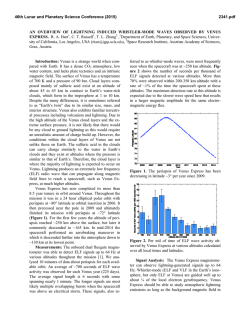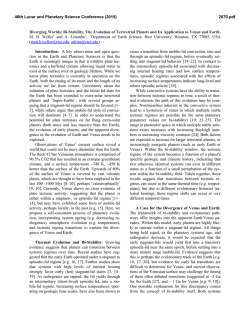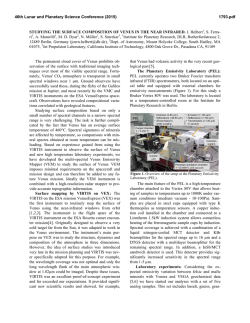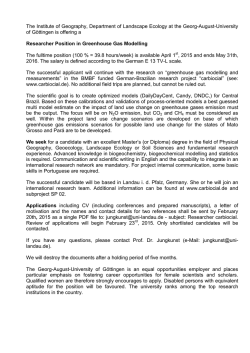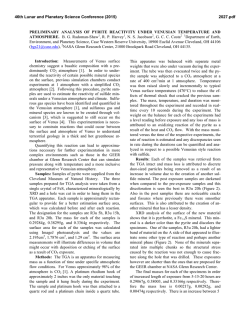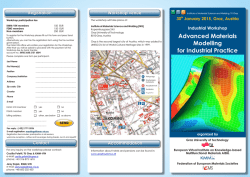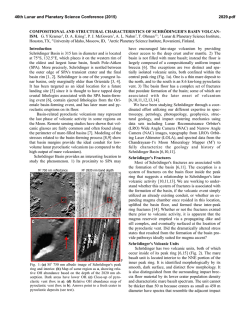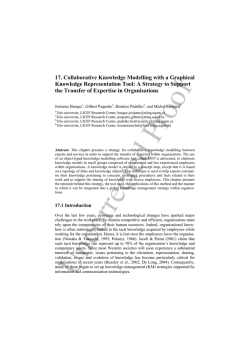
VOLCANIC EVENTS ON VENUS: OBSERVATIONS, MODELLING
46th Lunar and Planetary Science Conference (2015) 1818.pdf VOLCANIC EVENTS ON VENUS: OBSERVATIONS, MODELLING, AND DETECTION. M. W. Airey1, T. A. Mather1, D. M. Pyle1, L. S. Glaze2, R. C. Ghail3, and C. F. Wilson4, 1Dept. of Earth Sciences, University of Oxford, South Parks Road, Oxford, OX1 3AN, UK. (email: [email protected]), 2NASA Goddard Space Flight Center (code 698), Greenbelt, MD 20771, USA., 3Dept. of Civil and Environmental Engineering, Skempton Building, Imperial College London, South Kensington Campus, London, SW7 2AZ, UK., 4Atmospheric, Oceanic, and Planetary Physics, Clarendon Laboratory, University of Oxford, Oxford, OX1 3PU, UK. Introduction: There has long been indisputable evidence for past volcanic activity on Venus (mainly the observations in the SAR data recorded by NASA’s Magellan mission) that has been described, classified, and catalogued in great detail [e.g. 1, 2]. However, the finer details of volcanic processes have remained harder to identify with the current paucity of direct observations and available geological and geochemical data for Venus. Compositional and textural differences between volcanogenic deposits on Venus are also difficult to understand, as existing datasets require a certain degree of individual interpretation when identifying deposits. In this presentation we aim to use modelling and comparative approaches with Earth observation in order to make some preliminary investigations into the finer details of Venusian volcanism pending extensive new additional datasets. Many factors influence how Venusian volcanism will differ from terrestrial volcanism. Among them are the atmospheric temperature and pressure, and the acceleration due to gravity, which we know, and the magma composition/temperature/volatile content, conduit dimensions/structure, and local geology, which we do not. In order to understand how volcanism occurs on Venus it is necessary to use what information exists along with analogy with terrestrial processes and modelling methods within estimated ranges of conditions. Methods: The approach to this study was to use theoretical modelling, along with radar analyses, in order to identify the range of volcanic behaviour occurring on Venus. Modelling. A campaign of volcanological numerical modelling was undertaken to explore the potential range of styles of behaviour of volcanoes under Venusian conditions [3, 4]. The core of the modelling work was the development of a steady-state, homogeneous flow conduit code adapted from the original method of [5]. Magma flow was simulated from the conduit base to the vent, whereupon the final parameter values could be used to infer the resulting style of eruption. For each run, the volatile degassing behaviour (H2O and/or CO2) was calculated using a basaltic magma of a composition reflecting the Venera 14 lander analysis [6], with the model of [7], which was subsequently incorporated into the conduit model. An existing subaerial plume model [8] (linked to the conduit code via a decompressed jet model) was also used in the study to investigate the likelihood of plume buoyancy and predict plume heights. As a final application of the model findings, case study regions on Venus were compared with current detection limits of H2O (from Venus Express) to explore whether or not orbital detection of volcanic events may be plausible. Radar observations. It is often assumed that virtually all volcanic deposits on Venus are the result of effusive lava flows, and that explosive volcanism is unable to occur due to the inferred outgassing and loss to space of most of the planetary inventory of H2O [9, 10] (the chief magmatic volatile on Earth), and the atmospheric pressure at Venus’ surface. However, recent evidence suggests that explosive volcanism may indeed have occurred in the form of a proposed pyroclastic deposit, Scathach Fluctus, and may even be more widespread than initially suspected [11]. In an attempt to differentiate between effusive and explosive deposits on Venus, the most comparable data for a number terrestrial deposits was inspected in order to identify a method of distinguishing between lavas and pyroclastics, with the findings then being applied to Venus. As the roughness, backscatter, and emissivity/reflectivity datasets are all that can be systematically investigated on Venus, comparable properties were sought from ESA’s ASAR (Envisat) and NASA’s MODIS (Terra/Aqua) datasets to best match the Magellan wavelengths, although this was not possible in all cases. Results: Through the modelling investigation, we found that the addition of CO2 to an H2O-driven eruption increases the final pressure, velocity, and volume fraction gas (Figure 1). Increasing vent elevation leads to a greater degree of magma fragmentation, due to the decrease in the final pressure at the vent, resulting in a greater likelihood of explosive activity. Increasing the magmatic temperature generates higher final pressures, greater velocities, and lower final volume fraction gas values with a correspondingly lower chance of explosive volcanism. Cross-sectionally smaller, and/or deeper, conduits were more conducive to explosive activity. It was found that, for explosive activity to occur at the location of Scathach Fluctus, the model suggests that a magmatic H2O content of ~4.5%, or a combined H2O/CO2 mix of ~6% would have been required to 46th Lunar and Planetary Science Conference (2015) [11], which may then be used as further case studies for the modelling procedure. 0.78 210 21 b Venus 20 0.77 200 0.76 190 0.75 180 0.74 170 0.73 160 0.72 150 19 17 16 15 14 Pressure (MPa) 18 Exit velocity (m s−1) Volume fraction exsolved gas form such a deposit. Very high values when the likely low H2O inventory of Venus is considered, however these values vary with the initial variable values. For example, cross-sectionally smaller conduits and/or higher-altitude vents require a smaller volatile content for magma fragmentation to occur and accessory CO2 reduces the need for very high H2O concentrations. Should explosive events occur, it was predicted by the plume code that buoyant columns up to ~20 km above the vent may potentially be achievable from highaltitude vents. Model results also suggest that explosive activity at Scathach Fluctus would result in an H2O flux of ~107 kg s-1. Were Scathach Fluctus emplaced in a single event, our model suggests that it may have been emplaced in a period of ~15 days, supplying 1-2 × 104 Mt H2O to the atmosphere locally. A sustained eruption of this scale might increase local atmospheric H2O abundance, which is generally spatially very invariable (30 [-5, +10] ppm [12]), by tens of ppm for long enough, and over an area large enough, to be a detectable anomaly by near-infrared nightside sounding using the 1.18 µm spectral window such as that carried out by the Venus Express/VIRTIS spectrometer. The result of the comparative analysis of radar properties highlighted that, although possible pyroclastic deposits on Venus may have a narrow range of radar properties (Figure 2), pending further study, the fact that successful large-scale differentiation of lavas and pyroclastics using large radar datasets is not feasible and a solution remains elusive with the currently available data. What remains potentially achievable however, is the investigation of, as yet unidentified, exceptional individual examples using the combination of radar properties and field relationships as used in 1818.pdf 13 12 11 0.71 0 0.5 1 1.5 2 Additional CO2 (%) 2.5 3 10 Figure 1. The response of volume fraction gas (black, solid curve), exit velocity (red, dot-dash curve), and pressure (blue, dashed curve) to an increasing concentration of CO2 (0-3%) added to magma of constant H2O concentration (3%). Values correspond to conditions at the volcanic vent of radius 25 m above a conduit of 5 km length, and a magmatic temperature of 1200 K at Venus' MPR. References: [1] Crumpler, L.S. and Aubele, J.C. (2000) Volcanism on Venus, in Encyclopedia of volcanoes, H. Sigurdsson, Editor. [2] Head, J.W., et al. (1992) Journal of Geophysical Research-Planets, 97, E8, 13153-13197 [3] Airey, M.W., et al. (2013) 44th LPSC [abstract #1282] [4] Airey, M.W., et al. (in review) Planetary and Space Science [5] Woods, A.W. (1995) Rev. Geophys., 33, 4, 495-530 [6] Surkov, Y.A., et al. (1984) Journal of Geophysical Research, 89, 393-402402 [7] Witham, F., et al. (2012) Computers & Geosciences, 45, 87-97 [8] Glaze, L.S., et al. (1997) J. Geophys. Res.-Atmos., 102, D5, 6099-6108 [9] De Bergh, C., et al. (1991) Science, 251, 4993, 547-549 [10] Grinspoon, D.H. (1993) Nature, 363, 6428, 428-431 [11] Ghail, R.C. and Wilson, L. (2013) Geological Society, London, Special Publications, 401 [12] Bézard, B., et al. (2011) Icarus, 216, 1, 173-183 Figure 2. Emissivity plotted against asperity (a measure of roughness corresponding to the wavelength of the ASAR radar for comparative purposes). Two thirds of the possible Venus pyroclastic deposits plot within narrow boundaries (red square), although they remain indistinguishable from some lava flows.
© Copyright 2025
